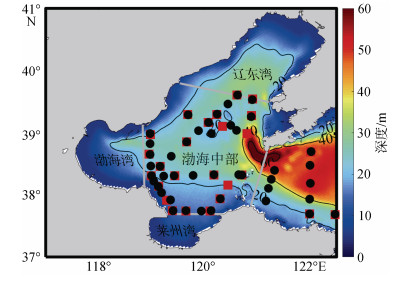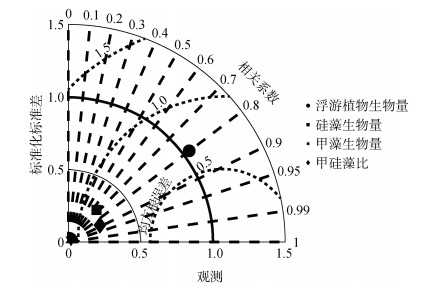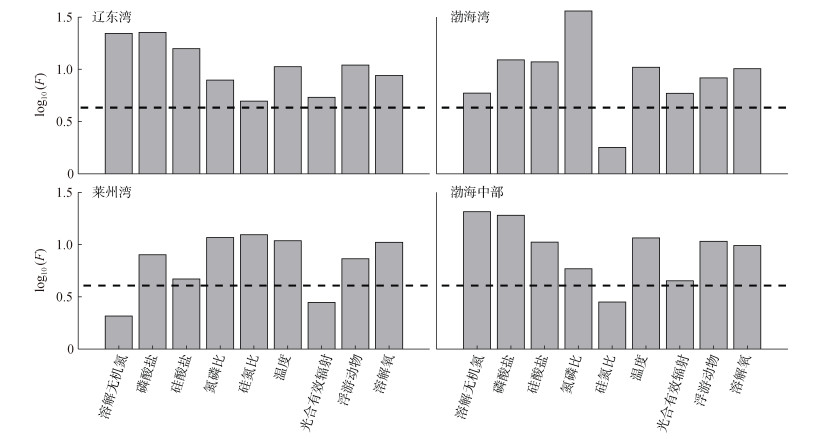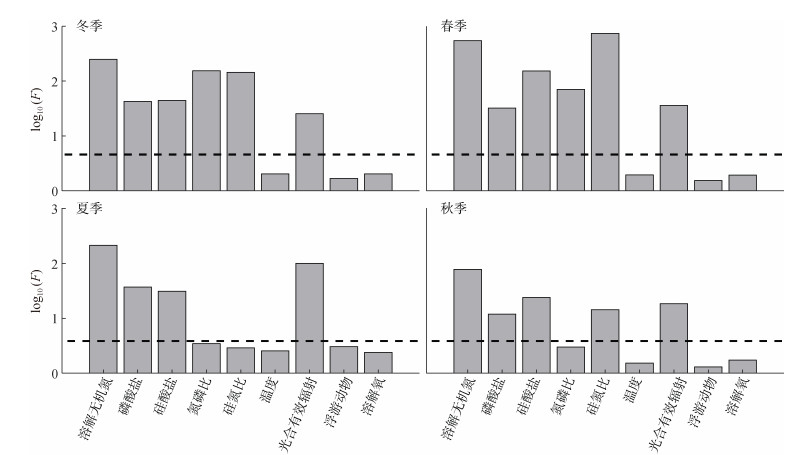文章信息
- 李子琳, 张海彦, 赵亮, 徐帆. 2021.
- LI Zi-lin, ZHANG Hai-yan, ZHAO Liang, XU Fan. 2021.
- 渤海浮游植物群落结构时空分布及其影响因素
- Spatial and temporal distribution and factors influencing the phytoplankton community structure in the Bohai Sea
- 海洋科学, 45(8): 10-20
- Marine Sciences, 45(8): 10-20.
- http://dx.doi.org/10.11759/hykx20210103001
-
文章历史
- 收稿日期:2021-01-03
- 修回日期:2021-04-19
2. 天津大学 海洋科学与技术学院, 天津 300072
2. School of Marine Science and Technology, Tianjin University, Tianjin 300072, China
浮游植物是海洋生态系统中重要的初级生产者, 约占海洋初级生产力的95%[1-2]。浮游植物群落结构的变化会对生物地球化学循环、全球气候以及渔业资源产生影响[1, 3-4]。渤海为中国的半封闭型内海, 环境承载能力小, 海水自净能力差, 是海洋生态环境问题最典型的区域之一[5]。研究表明, 渤海浮游植物群落结构主要由硅藻和甲藻组成[6-7]。近年来, 由于全球气候的变化以及人类活动的影响, 渤海生态系统的理化环境发生了明显变化, 浮游植物群落结构由硅藻占绝对优势逐渐转变为硅藻和甲藻共占优势[5, 8]。这种变化会影响初级生产力和更高营养级的结构, 导致有害藻类大量繁殖, 破坏生态系统结构[9]。此外, 浮游植物群落结构的时空分布易受复杂的环境因素影响[10-11]。因此, 对渤海浮游植物群落结构时空分布及其影响因素的分析, 是当今海洋生态学的研究热点之一。
自20世纪30年代, 国内外学者对渤海浮游植物群落结构的时空分布进行了研究。渤海表层浮游植物生物量和群落结构表现出明显的时空差异[1, 12]。从生物量上看, 4个区域中, 莱州湾生物量最高, 中央海区和辽东湾次之, 渤海湾最低[12-13]。生物量高值岀现的位置随季节有较大变化, 冬季整个渤海生物量都很低, 春季生物量从3个湾沿岸开始增加, 夏季高值区向中央海区扩散, 秋季高值区重新退到近岸[13]。通常年份生物量有两个高峰, 峰值分别出现在早春与夏末, 峰值出现时间依据地理位置不同有1个月左右的差别[14-15]。近年来, DING等[16]研究表明生物量在春夏季出现了1个高峰, 且最大值出现在夏季。从群落结构上看, 沿岸与外海甲硅藻比率差异显著[17]。其中甲硅藻比呈斑块状是其平面分布的主要特征[6]。甲硅藻比冬季最小, 夏季最大是其季节分布的主要特征[18]。浮游植物群落结构随季节发生变化, 冬季、春季以及秋季浮游植物群落以硅藻为主, 夏季浮游植物群落以硅藻和甲藻共同为主[6, 19-21]。渤海浮游植物生物量及其群落结构与环境因子密切相关。孙军等[8]基于实测数据指出浮游植物的地理和区系分布主要由温度和光照控制, 同时决定于其对营养盐的需求类型和自身的生长类型。赵亮[13]基于数值模型指出渤海浮游植物生产处于光和氮磷营养盐的交替控制下。刘晓慧等[22]基于实测数据指出浮游植物群落结构的时空分布受浮游动物捕食的影响。江涛等[23]基于实测数据指出浮游植物生物量高值主要分布于低氧区及邻近海域。受不同环境因子的影响, 浮游植物群落结构的时空分布具有明显的区域性和季节性差异[12, 24], 不同学者利用不同航次数据、遥感数据及数值模型, 给出了影响因子的差异。从区域性上看, 辽东湾内浮游植物群落结构的时空分布受温度、光合有效辐射、营养盐浓度及结构和溶解氧的影响[3, 9, 25]; 渤海湾内群落结构受温度、营养盐浓度及结构和溶解氧的影响[26-28]; 莱州湾内影响群落结构的重要环境因素是温度和营养盐浓度[29]; 渤海中部群落结构受到温度、无机氮、磷酸盐、硅酸盐、氮磷比和氮硅比的影响[30-31]。从季节性上看, 冬季, 低温和营养盐浓度是影响浮游植物生长的重要因素[7, 32-33]; 春季, 有利的光照条件、磷酸盐、硅酸盐、高氮磷比及低硅氮比是影响浮游植物群落结构的重要因素[16, 30, 34]; 夏季, 浮游植物群落结构与光照和营养盐浓度及结构等因素有关[1, 7, 10]; 秋季, 浮游植物群落结构主要受硅酸盐、铵盐、磷酸盐的浓度差异和温度降低的影响[6, 21]。总的来说, 不同季节不同区域渤海浮游植物群落结构时空分布的影响因子具有差异性。
数值模拟是一种将物理过程、生物过程定量化相关联的途径, 其目的在于揭示海洋生态系统的循环机制, 模拟和预测它的变化。考虑到浮游植物的快速增长、海洋环境的多变及获取长期数据集的高成本, 要定量分析浮游植物群落结构及其影响因素, 数值模拟成为一种有效途径[35-36]。本文采用物理生态耦合模型分析渤海浮游植物群落结构的时空变化特征, 并探究在不同季节内和不同区域内影响浮游植物群落结构分布的主要影响因素, 以期这一研究对改善渤海生态环境、预防生态灾害提供有益的参考。
1 数据与方法 1.1 物理生态耦合模型本文采用的是ROMS(regional ocean modeling system)-CoSiNE(the carbon, silicate and nitrogen ecosystem)物理生态耦合模型, 模型计算区域为29.04°N~ 42.09°N, 117.01°E~131.66°E, 覆盖了渤黄海及东海部分区域[37]。模型共包含15种生态变量, 模型详细配置和参数可以参考文献[37]。模拟时间为2006年—2017年, 本文主要分析最后一年的模拟结果。已有研究表明, 硅藻和甲藻是渤海的两大优势种[18, 31]。本文模型中包括硅藻和小型浮游植物两种浮游植物, 硅藻生物量用其叶绿素浓度(Chl2)表征, 甲藻生物量用小型浮游植物对应的其叶绿素浓度(Chl1)表征, 浮游植物总生物量用两者叶绿素之和(Chl1+Chl2)表征。群落结构以甲硅藻比对应的叶绿素浓度比例(Chl1︰Chl2)表征。根据海湾的定义, 将渤海分为辽东湾、渤海湾、莱州湾和渤海中部4个区域来讨论, 海湾分界如图 1灰线所示。
 |
| 图 1 模型计算区域, 本文研究区域和观测站位图 Fig. 1 Computational area of the model, study area and observation stations 等值线表示水深; 灰色线为海湾分界线; 红色方块表示2015年夏季观测站位; 黑色圆圈表示2017年夏季和冬季观测站位 The contour, gray line, red square, and black circle represent depth, Bay boundary, stations in summer 2015, and stations in summer and winter 2017, respectively |
钱思萌[37]已对该模型渤海物理场(环流、温度、盐度)和生态场(营养盐、叶绿素、溶解氧)的时空分布特征做了验证。罗辰奕[38]已对模型渤海浮游动物参数进行了优化。模型中浮游动物生物量夏季 > 春季 > 秋季 > 冬季, 与观测[39-40]特征一致。总体上, 模型的物理场和生态场能够较好地再现各变量的季节变化特征, 可用于进一步的分析研究。
本文采用了2015年夏季、2017年夏季和冬季3个航次的叶绿素实测数据(观测站位如图 1所示), 同时从文献中收集了2006—2016年间浮游植物生物量、硅藻生物量和甲藻生物量数据[1, 15-16, 30, 41-48], 数据覆盖了整个渤海海域, 包括了春季、夏季、秋季和冬季4个季节。从模型中选出与实测数据和文献数据的位置、时间及深度相同的点, 比较模拟结果与观测数据的相关性、均方根误差及标准化标准差(图 2)。结果显示: 浮游植物生物量模拟结果与观测数据的相关系数、均方根误差和标准化标准差分别为0.80、0.67和1.05。硅藻生物量模拟结果与观测数据的各系数分别为0.66、0.24和0.29。甲藻生物量模拟结果与观测数据的各系数分别为0.78、0.03和0.02。浮游植物生物量模拟结果与观测数据显著相关, 偏差较小, 离散程度较小。
 |
| 图 2 渤海浮植物生物量统计信息图 Fig. 2 Statistical map of phytoplankton biomass in the Bohai Sea 加粗实线代表观测; 圆圈代表浮游植物生物量; 正方形代表硅藻生物量; 六角星代表甲藻生物量 The solid line, circle, square, and hexagonal star represent the observation station, phytoplankton biomass, diatoms, and dinoflagellates, respectively |
根据张莹[30]对2013年—2014年渤海中部硅藻和甲藻生物量的观测结果, 本文计算了该区域春季、夏季和秋季甲硅藻比的平均值, 分别为0.02, 0.15和0.02, 相同时间及区域下模拟的甲硅藻比分别为0.04, 0.14和0.02。本文利用2015年春季、夏季和秋季渤海中部硅藻和甲藻特征色素[46], 得出甲硅藻比平均值分别为0.03, 0.22和0.11, 相同时间及区域下模拟的甲硅藻比分别为0.01, 0.25和0.09。总体上, 浮游植物生物量和甲硅藻比的模拟结果相对于观测数据的偏差较小, 且相关性较好, 可用于浮游植物群落结构的分析研究。
1.3 方差分析为了分析不同季节内和不同区域内浮游植物群落结构时空差异的影响因子, 本文采用IBM SPSS Statistics 23软件对可能影响浮游植物群落结构的因子进行方差分析, 确定主要影响因子。方差分析是用来检验不同影响因素的不同水平对因变量的影响是否显著。本文首先以4个季节(冬、春、夏、秋)为分组, 讨论造成各个区域内浮游植物群落结构季节差异的主要影响因子; 然后以4个区域(辽东湾、渤海湾、莱州湾、渤海中部)为分组, 讨论造成不同季节内浮游植物群落结构空间差异的主要影响因子。通过对比不同影响因素水平的数据组间方差和组内方差, 推断各因素是否造成因变量存在显著性差异。若存在显著性差异, 再判断因素对组间差异影响力的大小[49]。组间和组内误差平方和计算公式见(1):
| $ \left\{ \begin{matrix} \text{SSA}=\sum\limits_{i=1}^{k}{\sum\limits_{j=1}^{{{n}_{i}}}{{{(\overline{{{x}_{i}}}-\overline{\overline{x}})}^{2}}}} \\ \text{SSE}=\sum\limits_{i=1}^{k}{\sum\limits_{j=1}^{{{n}_{i}}}{{{({{x}_{ij}}-\overline{{{x}_{i}}})}^{2}}}} \\ \end{matrix} \right., $ | (1) |
其中, SSA为组间误差平方和、SSE为组内误差平方和。i=1, 2, …, k, k为组数。j=1, 2, …, ni, n为影响因子个数。
为了构造检验统计量F, 需要计算组间方差MSA和组内方差MSE, 它们的自由度分别为: k–1与n–k。计算公式见(2):
| $ \text{MSA}=\frac{\text{SSA}}{k-1}, \text{MSE}=\frac{\text{SSE}}{n-k}, $ | (2) |
组内方差与组间方差之比服从F分布。根据给定的显著性水平p和统计量F得出结论。当p值大于假设检验的显著性水平时, 说明因素的不同水平对于数据总体没有影响; 反之, 当p值小于假设检验的显著性水平, 说明因素的不同水平对于数据总体有影响。对于本文数据来说, F值越大, 说明因子对浮游植物群落结构季节变化和空间分布差异的影响越显著。统计量F计算公式见(3):
| $ F=\frac{\text{MSA}}{\text{MSE}}。$ | (3) |
根据ROMS-CoSiNE的模拟结果, 给出了渤海表层叶绿素浓度和浮游植物群落结构的水平分布和季节变化特征。渤海浮游植物群落结构的时空分布受营养盐浓度及结构、温度、光合有效辐射、浮游动物和溶解氧等多个因素共同影响[30]。本文借助模型输出的溶解无机氮、磷酸盐和硅酸盐, 计算了氮磷比和硅氮比, 利用方差分析讨论不同因子对表层浮游植物群落结构季节和区域差异的影响。
2.1 叶绿素浓度的时空分布渤海表层叶绿素质量浓度(以下简称浓度)介于0.18 mg/m3~11.62 mg/m3, 平均值为2.12 mg/m3, 表现出明显的空间差异和季节变化特征(图 3), 周慧敏等[50]基于遥感数据得出叶绿素a浓度范围为0.21 mg/m3~11.54 mg/m3。冬季, 叶绿素浓度最低, 平均值为0.68 mg/m3。沿岸和渤海中部海域叶绿素浓度较高, 高值达到0.80 mg/m3以上。春季, 叶绿素浓度平均值为2.51 mg/m3。3个湾叶绿素浓度均为从湾顶到湾口递减, 以莱州湾西南部、渤海湾西部和辽东湾北部沿岸叶绿素浓度较高, 最高值大于4 mg/m3, 渤海中部海区为相对高值区。夏季, 4 mg/m3等值线扩展到渤海中部海域, 叶绿素浓度平均值为3.80 mg/m3。除了渤海中部浅滩附近海域叶绿素浓度仍保持较低外, 其他海域叶绿素浓度显著升高, 特别是中部洼地为高值区, 叶绿素浓度最高值位于渤海中部南端靠近黄河口附近海域, 高达8 mg/m3以上。秋季, 整个海域叶绿素浓度明显下降, 平均值为1.03 mg/m3, 沿岸及渤海中部海域叶绿素浓度较高, 高值达到1 mg/m3以上。
 |
| 图 3 渤海表层叶绿素浓度的时空分布 Fig. 3 Spatial and temporal distribution of chlorophyll on the surface of the Bohai Sea |
渤海4个区域表层叶绿素浓度一年中均出现了两个峰值, 峰值分别出现在春、夏两季, 最大值出现在夏季(图 4a)。DING等[16]和HAO等[51]研究也表明渤海叶绿素浓度最高值出现在夏季。辽东湾和渤海湾叶绿素浓度在3月达到第一个峰值, 7月叶绿素浓度达到第二个峰值。莱州湾叶绿素浓度在3月达到第一个峰值, 1—5月莱州湾叶绿素浓度均高于其他3个区域, 6月叶绿素浓度达到第二个峰值。渤海中部冬季叶绿素浓度最低; 春季叶绿素浓度逐渐升高, 3月达到1个小峰值后继续升高, 6月叶绿素浓度达到最大值, 5月—10月渤海中部叶绿素浓度高于其他3个湾, 然后再次降低, 达到冬季低值。总体上, 渤海叶绿素浓度峰值首先出现在3月的莱州湾和渤海湾, 其次出现在6月的渤海中部, 然后出现在7月辽东湾, 叶绿素浓度峰值随着纬度增加逐渐后移。
 |
| 图 4 叶绿素(a)和甲硅藻比(b)的季节变化 Fig. 4 Seasonal changes in chlorophyll content (a) and the dinoflagellate to diatom ratio (b) 蓝色线代表辽东湾; 红色线代表渤海湾; 橙色线代表莱州湾; 紫色线代表渤海中部 Blue, red, orange, and purple lines represent the Liaodong Bay, Bohai Bay, Laizhou Bay, and central Bohai Sea, respectively |
本文用甲藻与硅藻叶绿素比例表征浮游植物群落结构, 渤海表层甲硅藻比例平均值为0.15, 最大值为7.38, 夏季甲硅藻比最大, 冬季甲硅藻比最小(图 5)。冬季, 甲硅藻比平均值为0.02, 最大值为0.05, 沿岸甲硅藻比较高, 如黄河口附近、秦皇岛沿岸和渤海海峡处存在高值; 浮游植物群落结构以硅藻为主。春季, 甲硅藻比平均值为0.03, 最大值达到0.12; 甲硅藻比由南北向中间增加, 高值位于渤海中部海域; 浮游植物群落结构以硅藻为主。夏季, 甲硅藻比平均值为0.29, 最大值为1.12; 甲硅藻比分布具有较为明显的分散性, 在辽东湾中部最高, 达到1以上, 秦皇岛附近海域次之, 然后是黄河口附近海域、莱州湾, 渤海中部甲硅藻比最低; 浮游植物群落结构以硅藻和甲藻共同占优势。秋季, 甲硅藻比平均值为0.06, 最大值为0.26; 沿岸及渤海海峡北部甲硅藻比最高, 中部甲硅藻比较低; 整个秋季浮游植物群落结构以硅藻为主。历史研究表明, 2013年—2015年浮游植物群落结构在冬季、春季和秋季浮游植物群落结构均以硅藻占绝对优势, 夏季群落结构以硅藻和甲藻共同占优势[1, 3, 7]。这一结果与本文2017年浮游植物群落结构在各个季节的优势藻类一致。说明近几年浮游植物群落结构在各个季节是硅藻占优还是甲藻占优的情况差异不大。
 |
| 图 5 Blue, red, orange, and purple lines represent the Liaodong Bay, Bohai Bay, Laizhou Bay, and central Bohai Sea, respectively Fig. 5 Spatial and temporal distribution of the dinoflagellate to diatom ratio on the Bohai Sea surface |
渤海4个区域甲硅藻比在四季只出现1个峰值, 且均出现在夏季(图 4b)。11月—翌年4月各个区域甲硅藻比均很小。4月—6月渤海中部甲硅藻比均大于其他3个区域甲硅藻比, 并在6月达到最大值(0.60)。莱州湾、辽东湾、渤海湾甲硅藻比均在7月达到最大值(0.31、0.31、0.26)。四季中, 渤海湾甲硅藻比都小于其他3个区域甲硅藻比。硅藻占浮游植物群落结构的78%~98%, 平均占到92%。甲藻在夏季占浮游植物群落结构比率最大, 达到22%。有研究显示, 尽管近年来甲藻的水平有所上升, 但硅藻的优势地位仍能保持[18, 24]。
2.3 影响浮游植物群落结构时空差异的主要因子分析各个区域内以冬季、春季、夏季和秋季4季为分组, 对渤海4个区域内浮游植物群落结构季节差异的影响因子进行方差分析, 来定量判断造成不同区域内季节差异的主要影响因子(图 6)。首先在显著性水平为99%条件下(图 6黑色虚线)判断是否具有显著性差异, 进而判断组间方差, 组间方差越大, 浮游植物群落结构时空分布差异性的影响因子作用越显著。结果表明, 在辽东湾, 不同季节浮游植物群落结构的差异受磷酸盐和溶解无机氮的影响最大, 硅酸盐、浮游动物、温度、溶解氧、硅氮比和光合有效辐射的影响依次减小。YANG等[9]研究表明营养盐是辽东湾浮游植物季节差异的关键因素。在渤海湾, 不同季节浮游植物群落结构的差异受氮磷比的影响最大, 磷酸盐和硅酸盐、温度、溶解氧、浮游动物、溶解无机氮和光合有效辐射的影响较小。穆迪[28]指出氮磷比为渤海湾浮游植物季节差异的影响因子。在莱州湾, 不同季节浮游植物群落结构的差异受硅氮比和氮磷比的影响最大, 其次是溶解氧、温度、磷酸盐、浮游动物和硅酸盐。以往调查发现, 莱州湾浮游植物群落结构受营养盐结构的限制[52]。在渤海中部, 不同季节浮游植物群落结构的差异受溶解无机氮和磷酸盐的影响最大, 温度、硅酸盐、浮游动物、溶解氧、氮磷比和光合有效辐射的影响依次较小。有研究表明, 影响渤海中部浮游植物群落结构差异的主要因子为无机氮和磷酸盐[31]。其他因子与各个区域内群落结构季节差异关系不显著。
 |
| 图 6 渤海不同区域内浮游植物群落结构季节差异的主要影响因子 Fig. 6 Main factors influencing seasonal differences in the phytoplankton community structure in different regions of the Bohai Sea 柱状为F值; 虚线表示P值等于0.01 The column is F, the dotted line indicates that P = 0.01 |
各个季节内以辽东湾、渤海湾、莱州湾、渤海中部为分组, 通过方差分析, 讨论造成不同季节内群落结构区域差异的主要因子(图 7)。结果表明, 在冬季, 不同区域浮游植物群落结构的空间差异受溶解无机氮、氮磷比和硅氮比的影响较大, 其次是磷酸盐、硅酸盐和光合有效辐射。在春季, 浮游植物群落结构的区域差异受硅氮比和溶解无机氮的影响较大, 其次是硅酸盐、氮磷比、硅酸盐和光合有效辐射。在夏季, 浮游植物群落结构的区域差异受溶解无机氮的影响最大, 其次是光合有效辐射、磷酸盐和硅酸盐。在秋季, 浮游植物群落结构的区域差异受溶解无机氮的影响最大, 其次是硅酸盐、光合有效辐射、硅氮比和磷酸盐。其他因子与各个季节内群落结构区域差异关系并不显著。有研究表明, 各个季节浮游植物群落空间差异受营养盐的影响, 冬季和夏季浮游植物群落结构受氮、磷和硅的影响[7], 春季营养盐结构有益于浮游植物的生长[16], 硅酸盐和铵盐的浓度差异影响秋季浮游植物[21]。HAO等[51]指出光合作用通常与营养物质协同, 控制浮游植物的生长。总的来说, 各个季节内浮游植物群落结构区域差异均受到营养盐浓度和光合有效辐射影响。
 |
| 图 7 渤海不同季节浮游植物群落结构空间差异的主要影响因子 Fig. 7 Main factors influencing the spatial difference in the phytoplankton community structure during different seasons in the Bohai Sea 柱状为F值; 虚线表示P值等于0.01 The column is F, the dotted line indicates that P = 0.01 |
本文采用ROMS-CoSiNE物理生态耦合模型模拟结果, 模拟了渤海浮游植物生物量和群落结构的时空分布特征, 利用方差分析探讨了造成渤海不同区域内和不同季节内浮游植物群落差异的主要影响因子。
渤海表层叶绿素浓度冬季最低, 夏季最高。冬季, 中部叶绿素浓度较高; 春季, 3个湾叶绿素浓度均从湾顶到湾口递减, 渤海中部为相对高值区; 夏季, 除了渤海中部浅滩附近海域叶绿素浓度仍保持较低外, 其他海域叶绿素浓度显著升高; 秋季, 整个海域叶绿素浓度明显下降。
渤海表层甲硅藻比在冬季最小, 夏季最大。冬季, 沿岸甲硅藻比较高; 春季, 甲硅藻比由南北向中间升高; 夏季, 甲硅藻比的分布具有较为明显的分散性; 秋季, 沿岸及渤海海峡北部甲硅藻比最高, 中部甲硅藻比较低。冬季、春季和秋季浮游植物群落结构均以硅藻占绝对优势, 夏季以硅藻和甲藻共同占优。
渤海浮游植物群落结构的时空分布受营养盐浓度及结构、温度、光合有效辐射、浮游动物和溶解氧共同影响。在辽东湾, 浮游植物群落结构的季节差异受营养盐浓度的影响最大; 在渤海湾, 游植物群落结构的季节差异受氮磷比的影响最大; 在莱州湾, 浮游植物群落结构的季节差异受营养盐结构和温度的影响最大; 在渤海中部, 浮游植物群落结构的季节差异受溶解无机氮和磷酸盐的影响最大。在冬季, 浮游植物群落结构的区域差异受溶解无机氮、氮磷比及硅氮比的影响较大; 在春季, 浮游植物群落结构的区域差异受溶解无机氮和硅氮比的影响较大; 在夏季, 浮游植物群落结构的区域差异受溶解无机氮和光合有效辐射的影响较大; 在秋季, 浮游植物群落结构的区域差异受溶解无机氮的影响最大。
| [1] |
PAN H Z, LI A F, CUI Z G, et al. A comparative study of phytoplankton community structure and biomass determined by HPLC-CHEMTAX and microscopic methods during summer and autumn in the central Bohai Sea, China[J]. Marine Pollution Bulletin, 2020, 155: 111172. DOI:10.1016/j.marpolbul.2020.111172 |
| [2] |
JIA J J, GAO Y, ZHOU F, et al. Identifying the main drivers of change of phytoplankton community structure and gross primary productivity in a river-lake system[J]. Journal of Hydrology, 2020, 583: 124633. DOI:10.1016/j.jhydrol.2020.124633 |
| [3] |
张雪, 王俊, 高燕, 等. 2014年春季渤海浮游植物群落结构[J]. 海洋科学, 2020, 44(6): 45-55. ZHANG Xue, WANG Jun, GAO Yan, et al. Phytoplankton community structure in the Bohai Sea in the spring of 2014[J]. Marine Sciences, 2020, 44(6): 45-55. |
| [4] |
JIANG T, WANG L H, ZHANG F C, et al. Selective feeding of bay scallop Argopecten irradians on phytoplankton community revealed by HPLC analysis of phytopigments in Bohai Sea, China[J]. Journal of Oceanology Limnology, 2019, 37(5): 1746-1755. DOI:10.1007/s00343-019-8280-0 |
| [5] |
NING X R, LIN C L, SU J L, et al. Long-term environmental changes and the responses of the ecosystems in the Bohai Sea during 1960–1996[J]. Deep-Sea Research Part Ⅱ, 2010, 57(11): 1079-1091. |
| [6] |
杨阳, 孙军, 关翔宇, 等. 渤海网采浮游植物群集的季节变化[J]. 海洋通报, 2016, 35(2): 121-131. YANG Yang, SUN Jun, GUAN Xiangyu, et al. Seasonal variation of netz-phytoplankton community in Bohai Sea[J]. Marine Science Bulletin, 2016, 35(2): 121-131. |
| [7] |
WANG Y B, SUN Y Y, WANG C X, et al. Net-phytoplankton community structure and its environmental correlations in central Bohai Sea and the Bohai Strait[J]. Aquatic Ecosystem Health & Management, 2019, 22(4): 481-493. |
| [8] |
孙军, 刘东艳, 杨世民, 等. 渤海中部和渤海海峡及邻近海域浮游植物群落结构的初步研究[J]. 海洋与湖沼, 2002, 33(5): 461-471. SUN Jun, LIU Dongyan, YANG Shimin, et al. The preliminary study on phytoplankton community structure in the central Bohai Sea and the Bohai Strait and adjacent area[J]. Oceanologia et Limnologia Sinica, 2002, 33(5): 461-471. DOI:10.3321/j.issn:0029-814X.2002.05.002 |
| [9] |
YANG G J, WU Z X, SONG L, et al. Seasonal variation of environmental variables and phytoplankton community structure and their relationship in Liaodong Bay of Bohai Sea, China[J]. Oceanic and Coastal Sea Research, 2018, 17(4): 864-878. |
| [10] |
HILALUDDIN F, YUSOFF F M, TODA T. Shifts in diatom dominance associated with seasonal changes in an estuarine-mangrove phytoplankton community[J]. Marine Science and Engineering, 2020, 8(7): 528. DOI:10.3390/jmse8070528 |
| [11] |
PACZKOWSKA J, ROWE O F, FIGUEROA D, et al. Drivers of phytoplankton production and community structure in nutrient-poor estuaries receiving terrestrial organic inflow[J]. Marine Environmental Research, 2019, 151: 104778. DOI:10.1016/j.marenvres.2019.104778 |
| [12] |
FU Y Z, XU S G, LIU J W. Temporal-spatial variations and developing trends of Chlorophyll-a in the Bohai Sea, China[J]. Estuarine, Coastal and Shelf Science, 2016, 173: 49-56. DOI:10.1016/j.ecss.2016.02.016 |
| [13] |
赵亮. 渤海浮游植物生态动力学模型研究[D]. 青岛: 中国海洋大学, 2002. ZHAO Liang. A modeling study of the phytoplankton dynamic in the Bohai Sea[D]. Qingdao: Ocean University of China, 2002. |
| [14] |
许士国, 富砚昭, 康萍萍. 渤海表层叶绿素a时空分布及演变特征[J]. 海洋环境科学, 2015, 34(6): 898-903. XU Shiguo, FU Yanzhao, KANG Pingping. Seasonal and interannual variations of chlorophyll a in the surface layer of the Bohai Sea[J]. Marine Environmental Science, 2015, 34(6): 898-903. |
| [15] |
寿玮玮. 大气沉降对渤海营养盐的贡献及生态效应[D]. 上海: 华东师范大学, 2018. SHOU Weiwei. Contribution of atmospheric deposition to the nutrients and its ecological effect in the Bohai[D]. Shanghai: East China Normal University, 2018. |
| [16] |
DING X K, GUO X Y, ZHANG C, et al. Water conservancy project on the Yellow River modifies the seasonal variation of Chlorophyll-a in the Bohai Sea[J]. Chemosphere, 2020, 254: 126846. DOI:10.1016/j.chemosphere.2020.126846 |
| [17] |
卞少伟, 韩龙, 张震, 等. 2013年8月和11月辽东湾近岸海域浮游植物群落结构[J]. 湿地科学, 2016, 14(4): 493-498. BIAN Shaowei, HAN Long, ZHANG Zhen, et al. Community structure of phytoplankton in the offshore area of Liaodong Bay in August and November of 2013[J]. Wetland Science, 2016, 14(4): 493-498. |
| [18] |
栾青杉, 康元德, 王俊. 渤海浮游植物群落的长期变化(1959—2015)[J]. 渔业科学进展, 2018, 39(4): 9-18. LUAN Qingshan, KANG Yuande, WANG Jun. Long- term changes in the phytoplankton community in the Bohai Sea (1959–2015)[J]. Progress in Fishery Sciences, 2018, 39(4): 9-18. |
| [19] |
孙军, 刘东艳, 白洁, 等. 2001年冬季渤海的浮游植物群落结构特征[J]. 中国海洋大学学报, 2004, 34(3): 413-422. SUN Jun, LIU Dongyan, BAI Jie, et al. Phytoplankton community of the Bohai Sea in Winter 2001[J]. Journal of Ocean University of China, 2004, 34(3): 413-422. |
| [20] |
孙军, 刘东艳, 徐俊, 等. 1999年春季渤海中部及其邻近海域的网采浮游植物群落[J]. 生态学报, 2004, 24(9): 1643-1655. SUN Jun, LIU Dongyan, XU Jun, et al. The netz-phytoplankton community of the central Bohai Sea and its adjacent waters in spring 1999[J]. Acta Ecologica Sinica, 2004, 24(9): 1643-1655. |
| [21] |
孙军, 刘东艳, 王威, 等. 1998年秋季渤海中部及其邻近海域的网采浮游植物群落[J]. 生态学报, 2004, 24(8): 72-84. SUN Jun, LIU Dongyan, WANG Wei, et al. The netz- phytoplankton community of the central Bohai Sea and its adjacent waters in autumn, 1998[J]. Acta Ecologica Sinica, 2004, 24(8): 72-84. |
| [22] |
刘晓慧, 徐宾铎, 张崇良, 等. 黄河口及其邻近水域浮游动物群落结构特征及其季节变化[J]. 中国水产科学, 2017, 24(5): 922-930. LIU Xiaohui, XU Binduo, ZHANG Chongliang, et al. Characteristics of zooplankton community structure and its seasonal variation in the Yellow River estuary and its adjacent waters[J]. Journal of Fishery Sciences of China, 2017, 24(5): 922-930. |
| [23] |
江涛, 曲克明, 徐勇, 等. 渤海中部海域低氧区的发生记录[J]. 渔业科学进展, 2016, 37(4): 1-6. JIANG Tao, QU Keming, XU Yong, et al. Report on the occurrence of hypoxia in the central Bohai Sea[J]. Progress in Fishery Sciences, 2016, 37(4): 1-6. |
| [24] |
孙萍, 李瑞香, 李艳, 等. 2005年夏末渤海网采浮游植物群落结构[J]. 海洋科学进展, 2008, 26(3): 354-363. SUN Ping, LI Ruixiang, LI Yan, et al. The net-phytoplankton community structure of the Bohai Sea in late summer, 2005[J]. Advances in Marine Science, 2008, 26(3): 354-363. DOI:10.3969/j.issn.1671-6647.2008.03.011 |
| [25] |
韩龙. 2013年夏季辽东湾浮游植物与环境因子的灰色关联评价[C]//北京: 中国环境科学学会, 2015: 4. HAN Long. Evaluation of the grey correlation between phytoplankton and environmental factors in Liaodong Bay in summer 2013[C]//Beijing: Chinese Society for Environmental Sciences, 2015: 4. |
| [26] |
WANG H L, LI S P, FENG J F. Research on measurable nonlinear relationship between phytoplankton biomass and environmental factors in Bohai Bay[J]. Marine Science Bulletin, 2005, 7(1): 82-86. |
| [27] |
武丹, 韩龙, 梅鹏蔚, 等. 渤海湾浮游植物群落特征及其环境影响因子[J]. 环境科学与技术, 2016, 39(4): 68-73. WU Dan, HAN Long, MEI Pengwei, et al. Community characteristics of phytoplankton and its environment impact factors in Bohai Bay[J]. Environmental Science & Technology, 2016, 39(4): 68-73. |
| [28] |
穆迪. 渤海湾营养盐对浮游生态动力学特性影响研究[D]. 天津: 天津大学, 2012. MU Di. The influence of nutrients on the dynamics of the plankton of Bohai Bay[D]. Tianjin: Tianjin University, 2012. |
| [29] |
孙慧慧, 刘西汉, 孙西艳, 等. 莱州湾浮游植物群落结构与环境因子的时空变化特征研究[J]. 海洋环境科学, 2017, 36(5): 662-669. SUN Huihui, LIU Xihan, SUN Xiyan, et al. Temporal and spatial variations of phytoplankton community and environmental factors in Laizhou Bay[J]. Marine Environmental Science, 2017, 36(5): 662-669. |
| [30] |
张莹. 渤海中部浮游植物与环境因子的空间关系及季节差异分析[D]. 烟台: 中国科学院烟台海岸带研究所, 2016. ZHANG Ying. Spatial correlation and seasonal variation of phytoplankton and environmental factors in the central Bohai Sea[D]. Yantai: Yantai Institute of Coastal Zone Research Chinese Academy of Sciences, 2016. |
| [31] |
孙雪梅, 徐东会, 夏斌, 等. 渤海中部网采浮游植物种类组成和季节变化[J]. 渔业科学进展, 2016, 37(4): 19-27. SUN Xuemei, XU Donghui, XIA Bin, et al. Species composition and seasonal variation of netz-phytoplankton in the central Bohai Sea[J]. Progress in Fishery Sciences, 2016, 37(4): 19-27. |
| [32] |
SUN J, LIU D Y, QIAN S B. Preliminary study on seasonal succession and development pathway of phytoplankton community in the Bohai Sea[J]. Acta Oceanologica Sinica, 2001, 20(2): 251-260. |
| [33] |
LIU D Y, WANG Y Q. Trends of satellite derived chlorophyll-a (1997-2011) in the Bohai and Yellow Seas, China: Effects of bathymetry on seasonal and inter- annual patterns[J]. Progress in Oceanography, 2013, 116: 154-166. DOI:10.1016/j.pocean.2013.07.003 |
| [34] |
刘丽雪, 王玉珏, 邸宝平, 等. 2012年春季渤海中部及邻近海域叶绿素a与环境因子的分布特征[J]. 海洋科学, 2014, 38(12): 8-15. LIU Lixue, WANG Yujue, DI Baoping, et al. Spatial distribution of chlorophyll a and environmental factors in the Bohai Sea in spring of 2012[J]. Marine Sciences, 2014, 38(12): 8-15. DOI:10.11759/hykx20140123002 |
| [35] |
SHI J, LENG Q, ZHU J Y, et al. Influences of nutrient sources on the alternation of nutrient limitations and phytoplankton community in Jiaozhou Bay, Southern Yellow Sea of China[J]. Sustainability, 2020, 12(6): 2224. DOI:10.3390/su12062224 |
| [36] |
魏皓, 赵亮, 冯士筰. 渤海浮游植物生物量与初级生产力变化的三维模拟[J]. 海洋学报, 2003, 25(S2): 66-72. WEI Hao, ZHAO Liang, FENG Shizuo. Annual cycle of phytoplankton biomass and primary production in the Bohai Sea simulated by a three-dimensional ecosystem model[J]. Acta Oceanologica Sinica, 2003, 25(S2): 66-72. |
| [37] |
钱思萌. 渤海中部低氧现象的数值模拟研究[D]. 天津: 天津大学, 2018. QIAN Simeng. Simulation on formation of summer low oxygen zone in the Bohai Sea[D]. Tianjin: Tianjin University, 2018. |
| [38] |
罗辰奕. 渤黄海ROMS-CoSiNE模型关键生态参数的优化与应用[D]. 天津: 天津大学, 2018. LUO Chenyi. Optimization and application of key parameters in a coupled ROMS-CoSiNE model of the Bohai and Yellow seas[D]. Tianjin: Tianjin University, 2018. |
| [39] |
卜亚谦, 朱丽岩, 陈香, 等. 夏冬季渤海–北黄海浮游动物群落结构及其与环境因子的关系[J]. 中国海洋大学学报, 2019, 49(2): 59-66. BU Yaqian, ZHU Liyan, CHEN Xiang, et al. Community structure of zooplankton and its relationship with environmental factors in the Bohai and the North Huanghai Sea in summer and winter[J]. Journal of Ocean University of China, 2019, 49(2): 59-66. |
| [40] |
杜明敏, 刘镇盛, 王春生, 等. 中国近海浮游动物群落结构及季节变化[J]. 生态学报, 2013, 33(17): 5407-5418. DU Mingmin, LIU Zhensheng, WANG Chunsheng, et al. The seasonal variation and community structure of zooplankton in China sea[J]. Acta Ecologica Sinica, 2013, 33(17): 5407-5418. |
| [41] |
冷晓云. 中国北方近海营养盐分布与浮游植物生物量[D]. 天津: 天津科技大学, 2016. LENG Xiaoyun. The distribution of nutrients and phytoplankton biomass in North China Sea[D]. Tianjin: Tianjin University of Science and Technology, 2016. |
| [42] |
王毅波, 孙延瑜, 王彩霞, 等. 夏季渤海网采浮游植物群落和叶绿素a分布特征及其对渔业资源的影响[J]. 渔业科学进展, 2019, 40(5): 42-51. WANG Yibo, SUN Yanyu, WANG Caixia, et al. Distribution of net-phytoplankton community and chlorophyll a in the Bohai Sea in summer and its impacts on fishery resources[J]. Progress in Fishery Sciences, 2019, 40(5): 42-51. |
| [43] |
周艳蕾, 张传松, 石晓勇, 等. 黄渤海海水中叶绿素a的分布特征及其环境影响因素[J]. 中国环境科学, 2017, 37(11): 4259-4265. ZHOU Yanlei, ZHANG Chuansong, SHI Xiaoyong, et al. Distribution characteristics of chlorophyll a and its influencing environmental factors in Bohai Sea and Yellow Sea[J]. China Environmental Science, 2017, 37(11): 4259-4265. DOI:10.3969/j.issn.1000-6923.2017.11.031 |
| [44] |
王昆, 吴景, 杜静, 等. 夏季和冬季辽东湾海域水体中叶绿素a含量分布特征[J]. 水产科学, 2016, 35(6): 675-680. WANG Kun, WU Jing, DU Jing, et al. Distribution of chlorophyll a concentration in sea waters of Liaodong Bay in summer and winter[J]. Fisheries Science, 2016, 35(6): 675-680. |
| [45] |
李晓玺. 基于MODIS数据的2003—2015年渤海NPP时空分布及影响因子研究[D]. 石家庄: 河北师范大学, 2017. LI Xiaoxi. Research on temporal and spatial distribution and influence factors of NPP in Bohai Sea based on MODIS from 2003 to 2015[D]. Shijiazhuang: Hebei Normal University, 2017. |
| [46] |
郑耀洋. 渤海中部海域浮游植物种群结构、光合色素和粒径特征研究[D]. 广州: 暨南大学, 2016. ZHENG Yaoyang. Studies on phytoplankton in the central Bohai Sea: community structure, photosynthetic pigments and size characteristics[D]. Guangzhou: Jinan University, 2017. |
| [47] |
李楠, 孙德勇, 环宇, 等. 黄渤海浮游植物种群比吸收光谱的确定及其应用[J]. 光学学报, 2020, 40(6): 34-43. LI Nan, SUN Deyong, HUAN Yu, et al. Determination and application of specific absorption spectra of phytoplankton species in Yellow Sea and Bohai Sea[J]. Acta Optica Sinica, 2020, 40(6): 34-43. |
| [48] |
李晓倩. 黄渤海浮游植物沉降速率的研究[D]. 天津: 天津科技大学, 2017. LI Xiaoqian. The study of phytoplankton sinking rate in the Yellow Sea and Bohai Sea[D]. Tianjin: Tianjin University of Science and Technology, 2017. |
| [49] |
戴金辉, 袁靖. 单因素方差分析与多元线性回归分析检验方法的比较[J]. 统计与决策, 2016, 453(9): 23-26. DAI Jinhui, YUAN Jing. Comparison of test methods of one-way ANOVA and multiple linear regression analysis[J]. Statistics and Decision, 2016, 453(9): 23-26. |
| [50] |
周慧敏, 冯剑丰, 朱琳, 等. 基于GAM的渤海中部水体叶绿素a环境因子影响分析[J]. 海洋环境科学, 2014, 33(4): 531-536. ZHOU Huimin, FENG Jianfeng, ZHU Lin, et al. Effects of environmental factors on the chlorophyll a in central Bohai Sea with GAM[J]. Marine Environmental Science, 2014, 33(4): 531-536. |
| [51] |
HAO Q, CHAI F, XIU P, et al. Spatial and temporal variation in chlorophyll a concentration in the Eastern China Seas based on a locally modified satellite dataset[J]. Estuarine, Coastal and Shelf Science, 2019, 220: 220-231. DOI:10.1016/j.ecss.2019.01.004 |
| [52] |
刘义豪, 杨秀兰, 靳洋, 等. 莱州湾海域营养盐现状及年际变化规律[J]. 渔业科学进展, 2011, 32(4): 1-5. LIU Yihao, YANG Xiulan, JIN Yang, et al. Distribution and inter-annual variation of nutrients in Laizhou Bay[J]. Progress in Fishery Sciences, 2011, 32(4): 1-5. DOI:10.3969/j.issn.1000-7075.2011.04.001 |
 2021, Vol. 45
2021, Vol. 45


